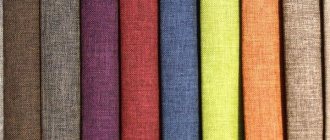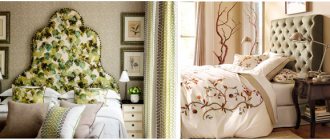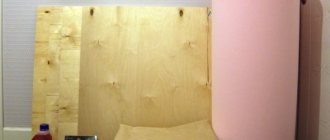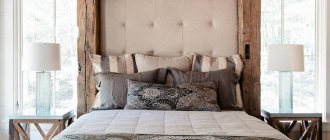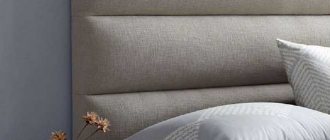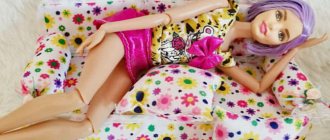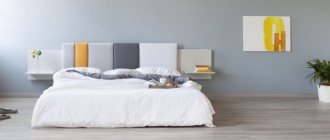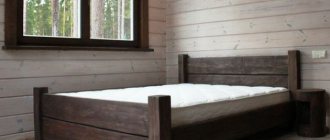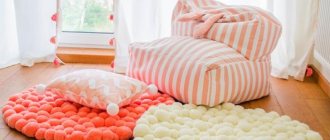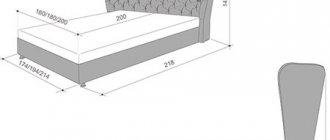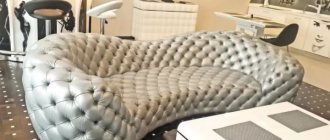A soft headboard with a French Capitonné screed adds elegance not only to the bed, but to the interior as a whole. Furniture with such decor is presentable and expensive, but don’t put off the purchase. We'll tell you how to create a soft headboard with capitonné decor yourself.
Materials and tools you will need:
- frame - this could be an old headboard, an unnecessary countertop, kitchen fronts or a door. The appearance of the frame is absolutely not important, because it will be covered with fabric;
- foam rubber;
- fabric – choose any material for upholstery that you like. It can be linen, cotton, velvet or leather;
- buttons on the leg - for a headboard measuring 180x200 cm you will need 37 pieces;
- plastic buttons - the same number of 37 pieces;
- twine or strong threads, thick needle , Moment glue;
- scissors;
- furniture stapler;
- drill and wood bit.
Materials and tools
First, let's decide what a headboard can be made from and what tools will be needed for this.
Materials:
- Wood (plywood, boards, planks, bars, depending on the chosen style);
- Fabric (for the base as well as the outer upholstery);
- Foam rubber or other soft padding;
- Accessories (buttons, buttons, cords, hooks, etc.).
Headboard Design
Tools:
- Electric puzzle;
- Construction stapler;
- Screwdriver;
- Self-tapping screws (or glue, depending on the manufacturing method);
- Scissors.
In order to make a headboard for a bed with your own hands, you must have at least minimal skills in working with these tools.
Simple upholstered headboard for bed
This method is suitable for those who want to decorate their home with a bed with a soft headboard, on which you can lean your back while sitting. The basis for such a backrest will be a rectangular sheet of plywood (it is advisable to choose the thickest one) of a suitable size. You will also need any thick fabric, a beautiful fabric for lining, as well as soft filling.
How to make a headboard:
- Two layers of foam are placed on top of each other on a sheet of plywood;
- A simple thick fabric is placed on top. It should extend beyond the edges of the foam and plywood by about 8 inches and be secured to the back of the frame using a staple gun.
- In the same way, the main fabric you have chosen for the headboard is stretched and pinned on top.
- As a result, you will get a soft rectangular structure that will serve as a headboard. This is done quite quickly, and the whole process can be completed in a few hours.
Subtleties of reupholstery
Many people decide to reupholster their headboard to give it a more attractive look. The most popular type is the carriage tie, which has been known since the 18th century. Previously, such trim was featured on carriages, hence the name. Today, this method is used in the design of furniture, as well as other decorative elements. The second name for the upholstery is capitonne.
To make the result of your work look impressive, you need to cover the headboard with expensive and rich material that will look good with a large number of folds. Such materials include velor and suede. Many people decide to cover their headboard with leather.
To carry out the reupholstery, you should prepare the following set of tools:
- furniture board or plywood, which will be used as a base;
- high quality fabric. You should purchase material with a margin of 30 cm more than the length and width of the plywood;
- foam rubber, the thickness of which is 5 cm. It should also be adjusted to the parameters of the selected plywood;
- padding polyester;
- buttons covered with fabric. They must have an ear;
- drill;
- knife;
- crochet hook;
- glue;
- laces. You can use rope or twine. Select the thickness taking into account the diameter of the button eye;
- stapler for furniture;
- wall fastenings and screws.
Subtleties of constriction:
- For such activities, you should choose a plywood sheet in the shape of a rectangle. If you wish, you can cut out the original shape that you like best;
- cutting of foam rubber is carried out based on the dimensions of the plywood itself. You will need to mark the material, indicating the area where the buttons will be attached. Most often, buttons are placed in a checkerboard pattern. Using a sharp knife, make button holes in the foam sheet;
- It is very convenient to make holes using a metal tube heated over a fire. You need to heat the pipe on a gas burner and quickly make holes. In one approach you can get about 2-3 holes. Do not forget to place a piece of board under the material so as not to damage the floor surface;
- Now you can put the material on the plywood and use a pencil to mark the places for the holes and make them with a drill. Use an 8mm wood drill bit;
We advise you to study - Types and rules for choosing diamond cutting discs for angle grinders
- the next step will be to glue the foam rubber to the plywood, taking into account that the holes for the buttons in both sheets are identical;
- On top you need to place one layer of padding polyester. Don't forget to leave a 5cm seam allowance for each side. The fabric is placed on the padding polyester, the supply of which is 10 cm on each side. Once you complete these steps, you can turn the future headboard over and secure the fabric to the plywood using a stapler;
- At this stage you can start preparing the buttons. You can reupholster them with textiles yourself or give them to the craftsmen. Thread a string through the eye of each button. Use laces that are at least 15 cm long and tie them in a knot. A crochet hook will be needed to thread the lace through the plywood;
- feel the hook on the fabric side. Use a ruler to measure the distance to a nearby button and make a small hole. You can use nail scissors for this purpose. Using a hook, pick up a button with a lace and thread them through the hole;
- the lace must be taut and properly attached with staples to the back;
- The last step is to secure and mount the headboard to the wall. For this purpose you will need self-tapping screws.
Curly headboard
Before you make an upholstered headboard the easy way, consider: wouldn't a beautifully curved and textured headrest look better? One of the beautiful headboard options is a curly back.
To make such a headrest for a bed, you need to cut the desired shape from a sheet of plywood. It is better to draw a sketch in advance, from which it will be easy to decide whether this shape is suitable for your bedroom, and whether there will be any problems with cutting it. The fabric is cut in the same way, but with a cut of 15-20 centimeters. Also, in addition to the stapler, you will need glue; it is better to choose a universal one for gluing fabric, foam rubber and wood.
Making a decorated headboard with your own hands:
- The selected shape is cut out of plywood with a jigsaw at the top of the sheet. The bottom should remain rectangular for fixation;
- The fabric is cut with scissors and a design is first applied to it with chalk or a bar of soap. Foam rubber is cut in the same way, but felt-tip pens or markers can be used for marking;
- The foam rubber is attached to the plywood with a stapler;
- Fabric is attached over the foam. It must be passed from behind, placing the structure in a vertical position, in reverse and secured with brackets. For better results, cuts can be made in the fabric;
- The edge of the headboard can be decorated with ribbons, fringe or special furniture potholders;
- To create additional texture, you can use the same nails to repeat the contour of the headboard, stepping back 10-15 centimeters from the edge.
A headrest made in this way will give the room not only an original design, but also additional comfort.
Wooden headboard
The easiest and cheapest way to get an original headboard with your own hands is to make it from wood. This option is suitable for those who are not afraid of toughness.
Of course, carved elements of bed linen from various types of natural wood would be a very beautiful option. But you can make them yourself only if you have carving skills and a set of necessary tools. In addition, valuable wood species cost a lot of money.
Therefore, the easiest way to make a wooden headboard is from plywood. The sheet can be cut out into any shape and then covered with paint, decorated with patterns, inscriptions, or even illuminated. It is better to fix it on the bed frame so as not to spoil the wall covering. This headboard can be replaced several times with your own hands.
A bed headboard made from boards will look original. Depending on the style chosen, they can be painted, decorated, or left unfinished. The decoration of such a headboard can also be anything. You can throw a variety of soft pillows at the base of the backrest to make the bed more comfortable.
Filler
A soft headboard implies the presence of filler. Previously, in the manufacture of such structures that can be found in old solid oak products, foam rubber and batting were used. Today, the choice of fillers is much wider; it depends on the manufacturer and cost of the bed. You should choose a filler based on your preferences:
In modern production, molded polyurethane foam is often used when making a bed from solid wood. The bottom line is that the filler is molded to fit the headboard blank, which makes this option clearly tailored to the dimensions of the frame. Replacing such a molded part will be problematic, and DIY repair is not recommended.
For those who like to tinker and repair with their own hands, it is often recommended to use batting, padding polyester and foam rubber. These materials are cheap, but their shelf life is significantly shorter than that of more modern solutions. In addition, if the litter is of poor quality, it can become a breeding ground for dust mites and trap excess moisture.
Headrest for a bed made of pillows
Another simple but fun way to make your own headboard is to use regular pillows. And they can be used in different ways.
In the first case, you will need a base for the headboard made of plywood, chipboard and other materials. You can make your own pillows or use ready-made ones. They should be attached along the edges with a furniture stapler to the base. This method is interesting because you can choose any color and pattern of pillows, it all depends on your imagination.
In the second option, the base is not used. Pillows (one long or several small ones) are simply hung on hooks. You can also make a hook mount from plywood, buy a ready-made hanger, or simply install hooks on the wall to hide them behind pillows.
Master class headboard in the form of soft squares
It’s easiest to make a soft headboard with your own hands in the form of individual squares. Even a beginner can cope with this process.
The production of the backrest begins with measurements. The width of the product should correspond to the width of the bed or slightly exceed it. The height is determined taking into account individual preferences and the desired effect.
Let's consider the stages of creating a headboard from 18 squares, arranged in 3 rows of 6 pieces (the size of each depends on the dimensions of the finished canvas).
First you need to purchase a sheet of plywood of the required size, mark a 3x6 grid on it and cut it using a hand saw or electric jigsaw. Then divide the fabric into squares with a margin of 5-10 cm on each side. If foam rubber is used for filling, at this stage you need to cut it into pieces equal to plywood squares.
To assemble, a piece of fabric is laid face down on a flat surface, foam rubber is placed on top of it, and then a square of plywood follows. To prevent displacement during upholstery, it is recommended to glue the foam rubber to the plywood. Do not use staples as this will cause deformation of the filler.
Armed with a stapler, you need to carefully, without allowing the components to move, secure the edges of the fabric around the perimeter, forming folds at the corners.
If padding polyester or batting is used instead of foam rubber, plywood is immediately laid on the fabric and 3 sides are nailed with staples. Then the element is filled through the resulting pocket, trying to place most of it in the center. Finally, the open side is closed and the edge of the fabric is secured with staples.
According to the diagram, the remaining squares are made and, using construction adhesive, they are attached to a large sheet of plywood, placing the parts as close as possible so that gaps do not form.
The final stage is hanging on the surface, creating a soft bed wall.
Method for making a soft headboard using the Carriage Screed technique
The “carriage tie” technique seems expensive and attractive, but in fact this headboard is created from several materials that are practically at hand.
Upholstered headboards with diamond upholstery look stunning.
The capitone method, as it is also called, is done in several steps.
- To begin with, a rough drawing, plywood or MDF sheet cut to shape is outlined.
- A sketch is drawn on a sheet of foam rubber, which will make it clear in which places to make the holes. Next, the circles are cut out exactly according to the drawing, and exactly the same holes are made in the plywood.
- The filler is glued to the main sheet with glue, after which you need to wait for the part to dry completely.
- After gluing, you need to cover the foam rubber with a thin layer of padding polyester, and continue with the final layer of fabric.
- When you cover the frame with fabric, you need to start from the edge, gradually moving towards the center. In this case, a needle and thread are threaded through each hole twice and fixed on the back side of a sheet of plywood or MDF with a stapler.
- After the entire surface is decorated in this way, the remaining fabric at the edges is wrapped over the drawing part and firmly fixed with a regular stapler.
In fact, making a carriage tie is much easier than it seems at first glance, but it will take a lot of your free time. By fastening with threads, parts of the upholstery are stretched, forming a specific pattern - a rhombus or a square, depending on the sequence chosen by the master.
A carriage tie looks beautiful, but is difficult to make.
You can leave it like this, or you can add a little “zest” and sew buttons, decorative fabric roses, and beads into the places where there are tears. Capitonne will look especially impressive with velvety fabric, leather or its substitute.
Selecting materials for panels
The range of applications for soft panels made of leather or fabric is huge, starting with small ottomans with a soft seat and ending with solid decoration for cafes and other similar places, but the use of such finishing in the interior is a big topic worthy of a separate article.
Soft walls and furniture in a cafe are beautiful and practical.
Now we are talking about the applied direction, and any work on the manufacture of anything begins with the selection of materials.
- Basis - here it all depends on the purpose for which you are making your panel. So, for furniture, for example, headrests for beds, MDF, chipboard or OSB boards with a thickness of about 10 - 12 mm are taken. Plywood works well, but is more expensive. Pure wall cladding or lining of entrance doors should not be too thick, so such panels are made on the basis of thin plywood or fiberboard;
- The filler or backing is responsible for softness and volume. As already mentioned, this often includes furniture foam up to 100 mm thick. Although there are some smooth models that are filled with padding polyester and even batting. For example, if you make yourself a soft ironing board, then it is filled only with batting;
Furniture foam rubber is the most practical backing for soft panels.
- The list of finishing materials for such panels consists of 3 points:
- Making soft wall panels covered with natural leather is a good option, but very expensive. After all, finely tanned leather is used for these purposes, and its price is high; not everyone can afford such a coating;
- Furniture fabrics, especially velvet, look impressive, but are difficult to care for. The more you vacuum and wash the fabric covering, the faster it will become unusable;
- Leatherette wall panels now occupy approximately 50–70% of the market. This material combines the best price with decent quality. Plus, you can wash artificial leather as much as you like.
The choice of eco-leather furniture is now huge.
Important: now all companies specializing in the production of soft panels use so-called eco-leather, in principle it is the same leatherette, only of very high quality. Visually, eco-leather is practically indistinguishable from natural leather, plus it stretches well and does not burn.
How to make a curved headboard with your own hands
Like any planned design, a figured headboard must first be drawn on paper. You can only do it on one side, eventually flipping it over, it will be just as symmetrical. In this example, we will look at a headboard decorated with a carriage bow.
Materials and tools:
- Foam rubber;
- Plywood;
- Textile;
- Ready-made figure image template;
- Construction stapler;
- Drill;
- Decorative buttons;
- Scissors;
- Decorative finishing.
Work process:
- As in the previous example, you need to drill holes in the foam, plywood and fabric, laying one on top of the other.
- We fasten the plywood and foam rubber with a stapler;
- We make the upholstery from the outer fabric, but first we need to sew on the buttons;
- The buttons should be secured with fishing line, which you thread through all the holes and secure with a stapler on the back side.
- Pin the fabric, trim off any excess pieces;
- Using volumetric edging we create a beautiful edge of the figured area.
Our work is done. You can use other fabrics, for example, velvet in dark shades will look rich; usually the same buttons are in harmony with it. And the figured design, depending on your imagination, can be completely different: in the form of mountains, arches, individual geometric shapes, in the Gothic style, etc.
Key points when choosing a headboard
The main parameters when choosing a headboard are appearance and comfort. For those who spend a lot of time in bed reading books and watching movies, a soft headboard is more suitable.
Taking into account the fact that people will often lean on the headboard of the bed, you should choose upholstery fabric that will be easy to care for (wear-resistant artificial or natural leather would be the best material).
We advise you to study - How to install a shower cabin in a private house
The hard back option is suitable for those for whom the design of the product is more important than comfort and functionality (for example, it is very uncomfortable to lean on a wrought-iron headboard and place a pillow on it). Here you can experiment with the shape of the backrest, taking into account the interior and concept of the bedroom. Suitable materials include wood, metal, and plastic profiles.
Regarding the choice of headboard fabric, you should pay attention to the following nuances:
- the backrest made of the selected fabric should fit into the interior of the bedroom;
- It is desirable that the fabric be wear-resistant and care for it does not bring inconvenience;
- When choosing textiles with large patterns (flowers, geometric shapes) in bright colors, it is recommended to limit the interior to only these prints, so as not to overload the appearance of the room.
Having considered the following styles of room interiors, you can decide on the appearance of the headboard for the bed, which will fit harmoniously into the bedroom, create coziness and determine the necessary accents:
The classic style assumes the correct geometric shape of the furniture. Pastel, calm shades combine with the color of wood. Often, for a classic-style bedroom, wooden headboards or rich options with carriage stitch are chosen.
Stages of manufacturing different types of headboards
Before you make a soft or hard headboard with your own hands, you need to calculate the dimensions of the element and prepare drawings based on them. Calculations must be made carefully, accurate to the millimeter, so that the finished product fits the bed perfectly in shape and size. If necessary, simple drawings and interesting headboard design ideas can be found on special thematic resources.
Hard wooden
For work you will need the simplest materials. The headboard can be made to the desired size for a 1-, 1.5- or 2-person bed. Before you start manufacturing, you need to prepare:
- chipboard;
- bars;
- puzzle;
- wood glue;
- matte white paint;
- corners and screws for fastening;
- screwdriver
Management:
- Cut a piece of plywood to the desired size. The headboard may protrude slightly beyond the edges of the bed or be flush with the sides.
- Cut the bars into the required quantity. If you want, paint or varnish them.
- Lay long bars horizontally along the edges, and lay short bars between them.
- Secure the elements with glue.
- Screw the headboard to the bed frame using angles and screws.
The rods can be arranged in any order, forming a specific pattern or ornament, securing them both horizontally and vertically.
A wooden headboard can be made according to the following plan:
- Sand the boards with sandpaper, removing all roughness, burrs and other defects.
- Cover the finished elements with varnish or paint.
- Using screws, build a kind of shield from the boards.
- If desired, reinforce the back with a sheet of plywood.
- Attach the finished headboard to the bed or conveniently hang it on the wall.
It is not necessary to make the back in the form of an even rectangle. If the interior style allows, you can imitate a fence or choose another unusual configuration. The advantages of a protective headboard are ease of manufacture and minimal financial costs.
Criteria for choosing a bed with a soft headboard, design options
Upholstery
The soft version of the headboard can be made in a variety of designs and shapes. This will take a little time, about 2 hours. No need to wait for glue or paint to dry.
Necessary materials:
- plywood;
- puzzle;
- foam;
- stapler;
- decorative fabric;
- loops for attaching the back.
Stages of work:
- Cut a piece of plywood to the desired size and shape.
- Attach a fill layer to it.
- Stretch the fabric over the foam so that the edges hang over the edge of the plywood.
- Fasten the textiles with a stapler, making neat turns at the back of the headboard.
- Using loops, secure the finished product to the bed.
A soft back can be made using another technique:
- Build a frame in the form of a rectangle from thin bars. The width of the base is selected individually.
- Place several sheets of foam rubber on the frame and secure them at the edges with a stapler.
- Cover the workpiece with leather or its equivalent. Make careful turns and trim corners if necessary. Secure the material with a stapler - the soft and practical upholstery is ready.
- Attach the headboard to the bed using loops.
A handmade soft headboard can be either part of the overall interior or its accent. The product does not have to be rectangular - the choice of shape depends on the skills and wishes of the craftsman.
Which style should you choose for your headboard?
This is the very first thing where you should start designing future headboard . In no case should it contradict the overall interior of the room or the style of the bed itself. Let's look at the most popular styles:
- Baroque . This style is preferred by people who want to emphasize their wealth. It includes a lot of gilding, expensive luxurious fabric, and artistic forging. The main atmosphere that this style creates is luxury , wealth , chic and pomp. A soft headboard made of velvet, brocade or other beautiful fabric with gold buttons will fit perfectly into such an interior. Or a mirrored headboard in a wide, beautiful carved frame, painted gold, or a canopy headboard made of heavy, light-proof fabric with gold garters with tassels at the ends. In general, everything that looks expensive, but is not a rectangular wooden headboard.
- Provence . A very light and pleasant style comes from France. This is a beautiful combination of classic style with rustic elements. French country houses are often decorated in this style. Characteristic features are the use of warm pastel shades , preference for natural materials with their natural texture, specially aged elements of wooden furniture and cute floral patterns. Wooden headboards with antique elements or panel headboards made of light light fabrics with an unobtrusive floral pattern are perfect for this style.
- Vintage. Home feature this styles are well visible and clearly defined antique elements, and not just old things, but those that really belong to past eras, precisely from the materials that were used in those times. Collecting decorative elements for this style is sometimes difficult. Color spectrum neutral and includes “faded” shades. For material headboards wood in its natural form, an old mirror, or a soft headboard made of light linen fabric or specially aged velvet are suitable.
- Art Deco. This style is very easy to recognize because predominance in him lines, stripes, broken curved lines and trapezoidal objects. It is characterized by natural rough surfaces, mirrors, stained glass. For an Art Deco style bedroom, it is preferable to use a large mirror, because this style implies a lot of space and light. It can also be used as a headboard. The colors of this style can be colorful, but always muted. Preferred shades brown, white or metallic. The color of the furniture should contrast with the color of the walls, and one of its elements must be of a non-standard shape. In addition to the mirror, a soft rectangular or trapezoidal fabric is well suited as a headboard.
- Loft . This style is loved by many due to its spaciousness . An integral element of this style is the presence of rough brickwork , often white. The main colors are white, gray, and shades of brown. Materials characteristic of this style are wood, glass, concrete, brick, chrome parts. This style combines rough finishes that have an unfinished look with modern technology. The furniture is simple, laconic and extremely practical. the headboard of the bed made of wood or make it soft, so it will create the effect of incompleteness, especially against the background of a brick wall.
- Eco style differs in use natural materials with preserving their textures. Color spectrum as close to natural as possible - shades of green, brown, yellow. Such an interior has a positive effect on human health, not only physical, but also mental, having a calming effect. Furniture - made of natural wood. The headboard of the bed can be like wooden, and soft, the main thing is to maintain the overall color scheme.
